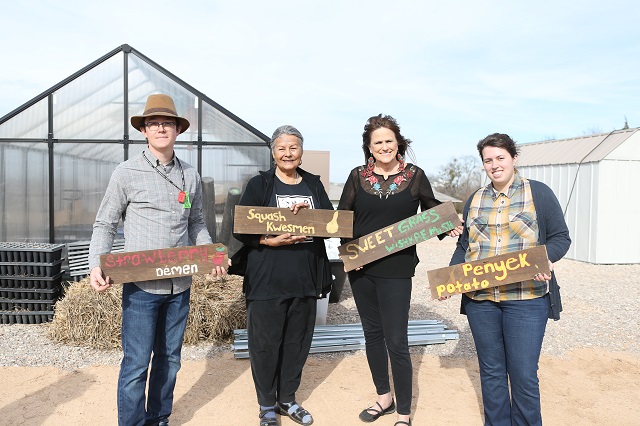
After three moves in the last four years, the Citizen Potawatomi Nation Community Garden has found a new home for the 2017 season. Assistant Tribal Historic Preservation Officer Andrew Gourd and other CPN staff members have done the bulk of the work moving the garden from the CPN Eagle Aviary to the Sharp House this fall. With this change comes great opportunity, but also another year of getting to know the personality of the space.
“Our new community garden is steps away from a prayer circle and small pond, which is a significant cultural space. It is just as important to me to manage the area outside of the garden as the area inside of the garden,” Gourd said.
Along with Gourd, the maintenance, roads and housekeeping departments have played a large role in making this a viable space for the garden. They’ve tilled the soil, created gravel spaces for the greenhouse and constructed several buildings, shaped the grounds and collected leaves from CPN grounds to put more organic components back into the soil.
“Not only do we want to create a community garden for people to enjoy, but we also want to create a beautiful and functional space,” Gourd said. “I want to rehabilitate this piece of land and make a peaceful retreat.”
Gourd created the layout of this year’s garden to implement a variety of projects for all volunteers, including elders and youth.
“A lot of thought goes into making it efficient, offering specific activities besides planting, harvesting and watering, like working in the greenhouse or raised beds,” said Gourd. “We needed to break up the large plot of land with raised beds and walkways, giving volunteers a more manageable space for the tasks they enjoy.”
He also consulted with several departments – like tribal youth, the Rekindling 7 Generations tribal mentorship program and the staff from FireLake Wellness Center – to determine the best fruits and vegetables to grow in the 2017 garden. There will be the addition of fruit trees and a hoop house, which will grow native plants that will encourage pollinators and butterflies to thrive in the space.
“The monarch initiative we did with Monarch Watch, Euchee Butterfly Farm and six other tribes in Oklahoma was the most successful program we did in 2016,” said Gourd. “It included hands-on learning, planting milkweed and educational events. At the end of January, we planted more milkweed in the hoop house and are looking for more grants to expand this program. It’s a great platform to talk about the impact that we have on the environment around us.”
In February, there is still construction to be done to get ready for planting in April. Buildings like the greenhouse, shed, and hoop house need to be erected and raised beds need to be built. After the buildings are completed, faucets with running water and electricity will be installed. Deer in the area have created a nice walking path through the woods, so redirecting that to keep them from eating the garden’s produce is on the to-do list for the first season.
March will be the month that volunteers begin seeding in the greenhouse, which allows community members to plant and harvest produce regardless of the season, so there aren’t several hundred pieces of okra ready for harvest in a two week window. There will be a rotation of crops and that will create a variety of projects for volunteers to help with.
“Organic gardening is always a work in progress,” Gourd said. “We will continue to grow what works for us, but we’re always trying new things, especially in our new space. Since it is a community garden, we want to give people the tools to shape the land into what they want it to be; that’s what makes it a community garden.”
If you are interested in getting involved with the 2017 community garden, please contact Gourd at (405) 878-5830.
